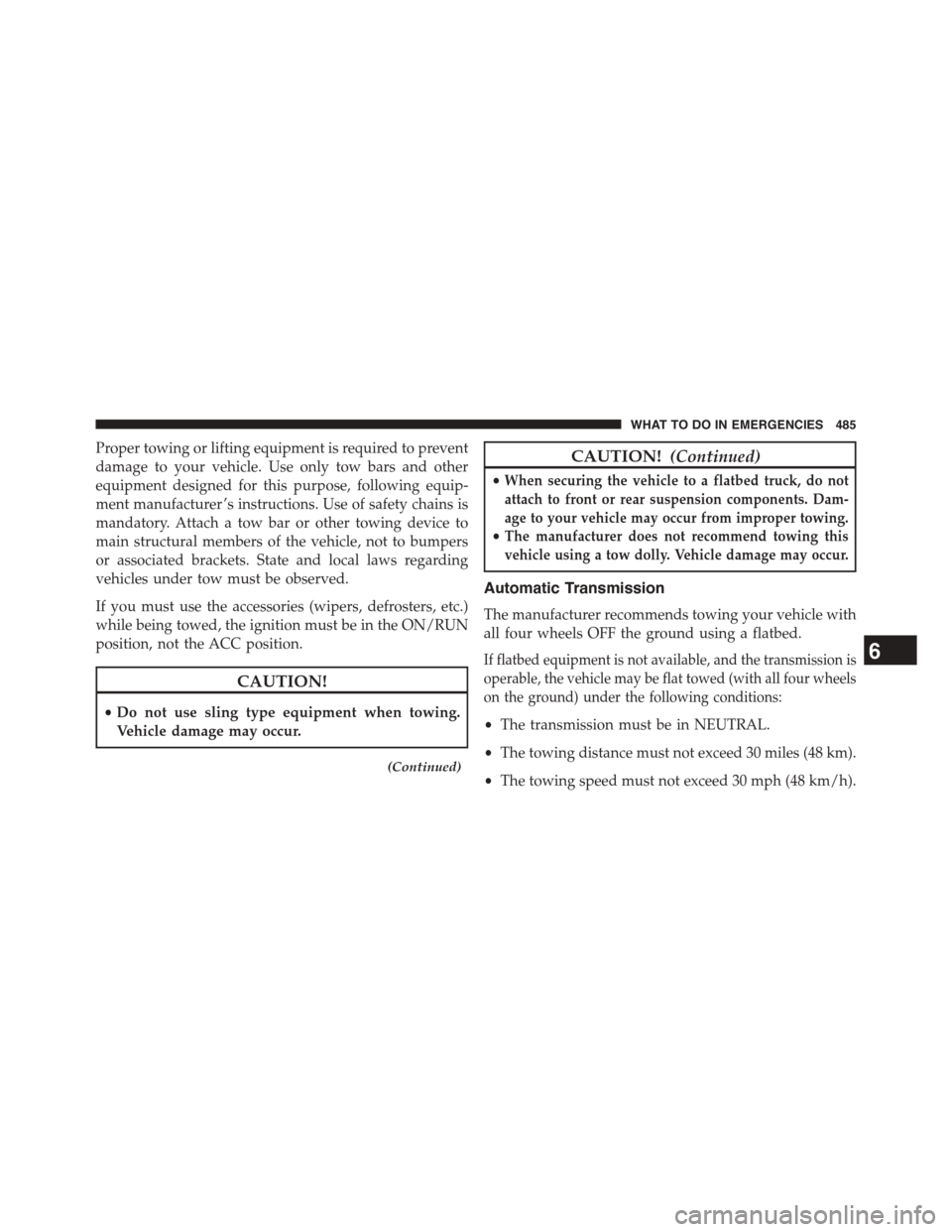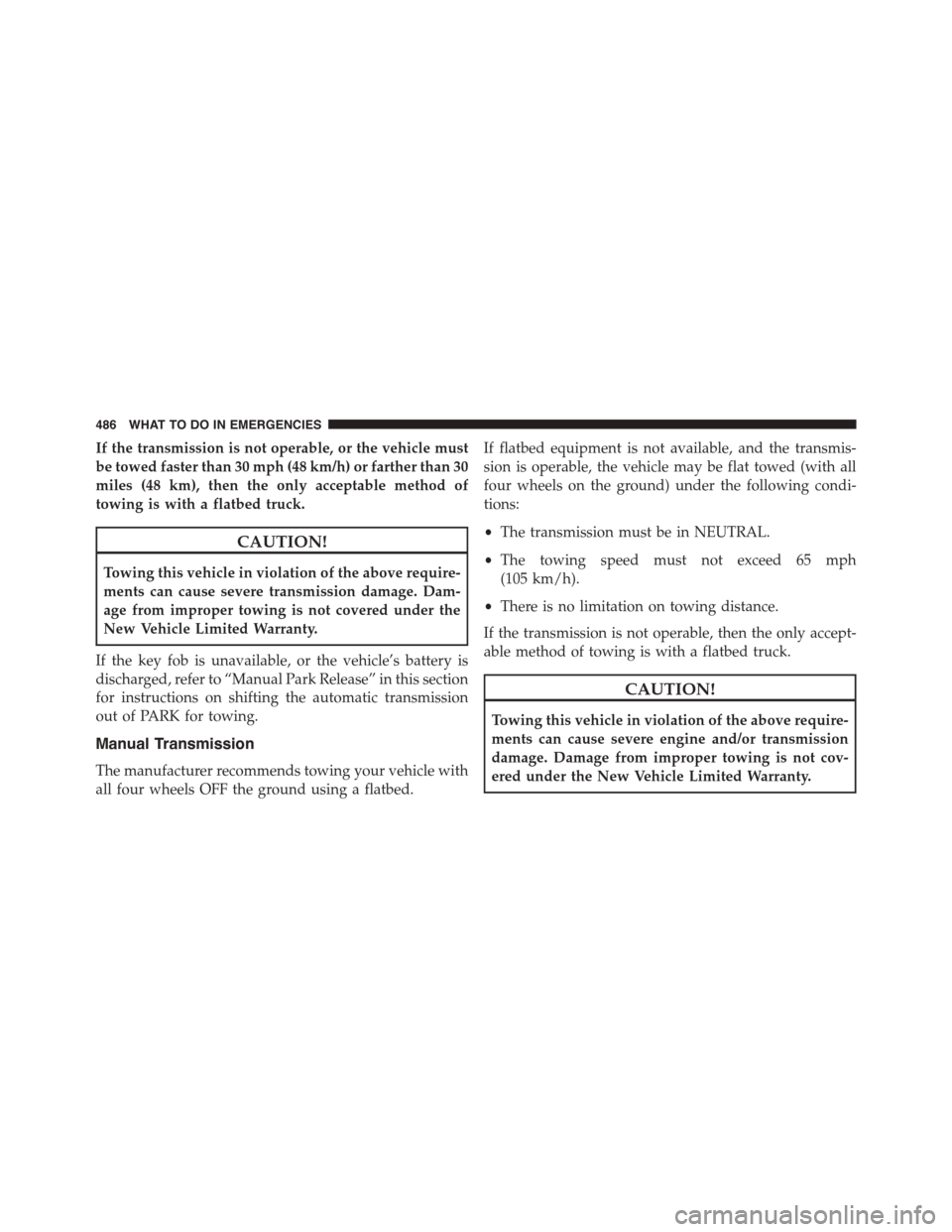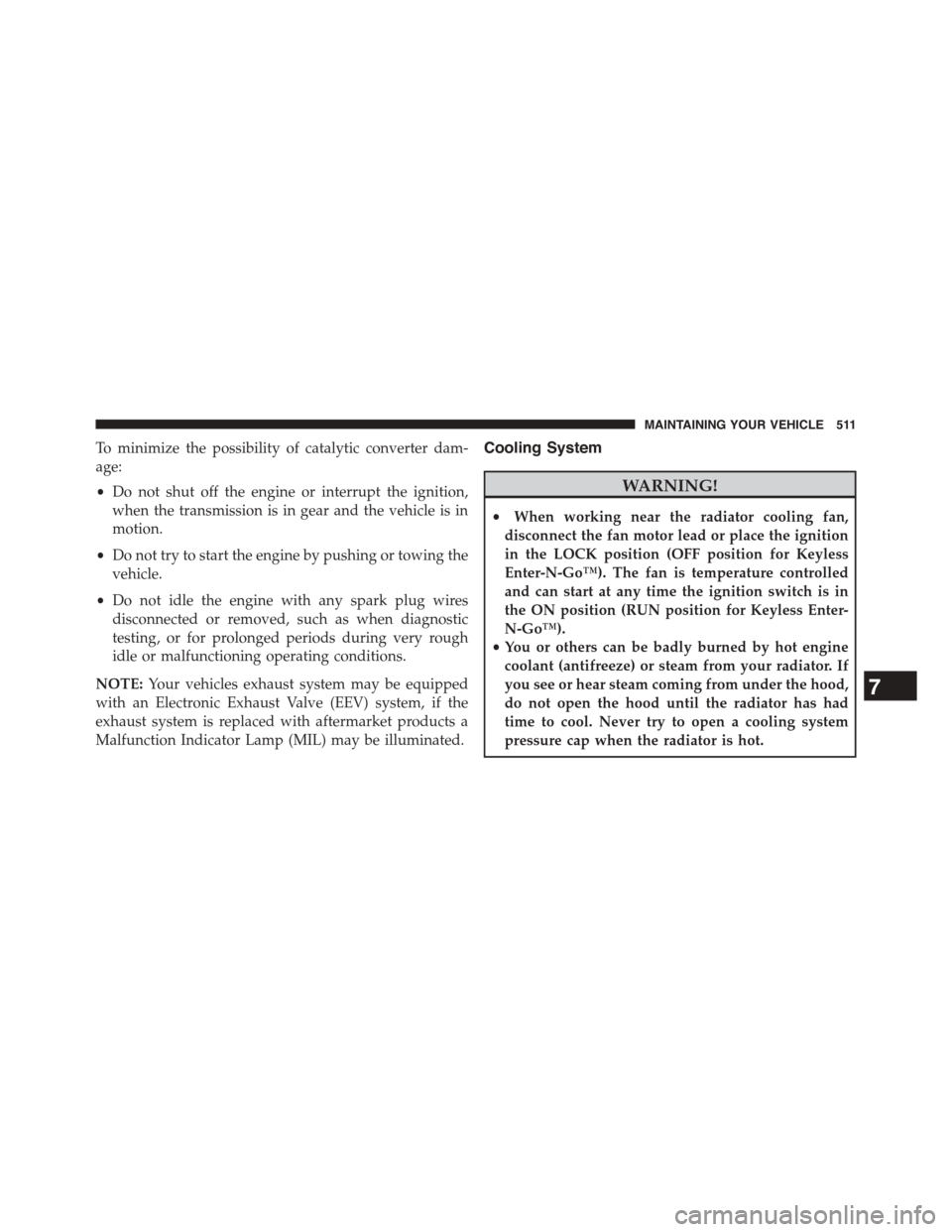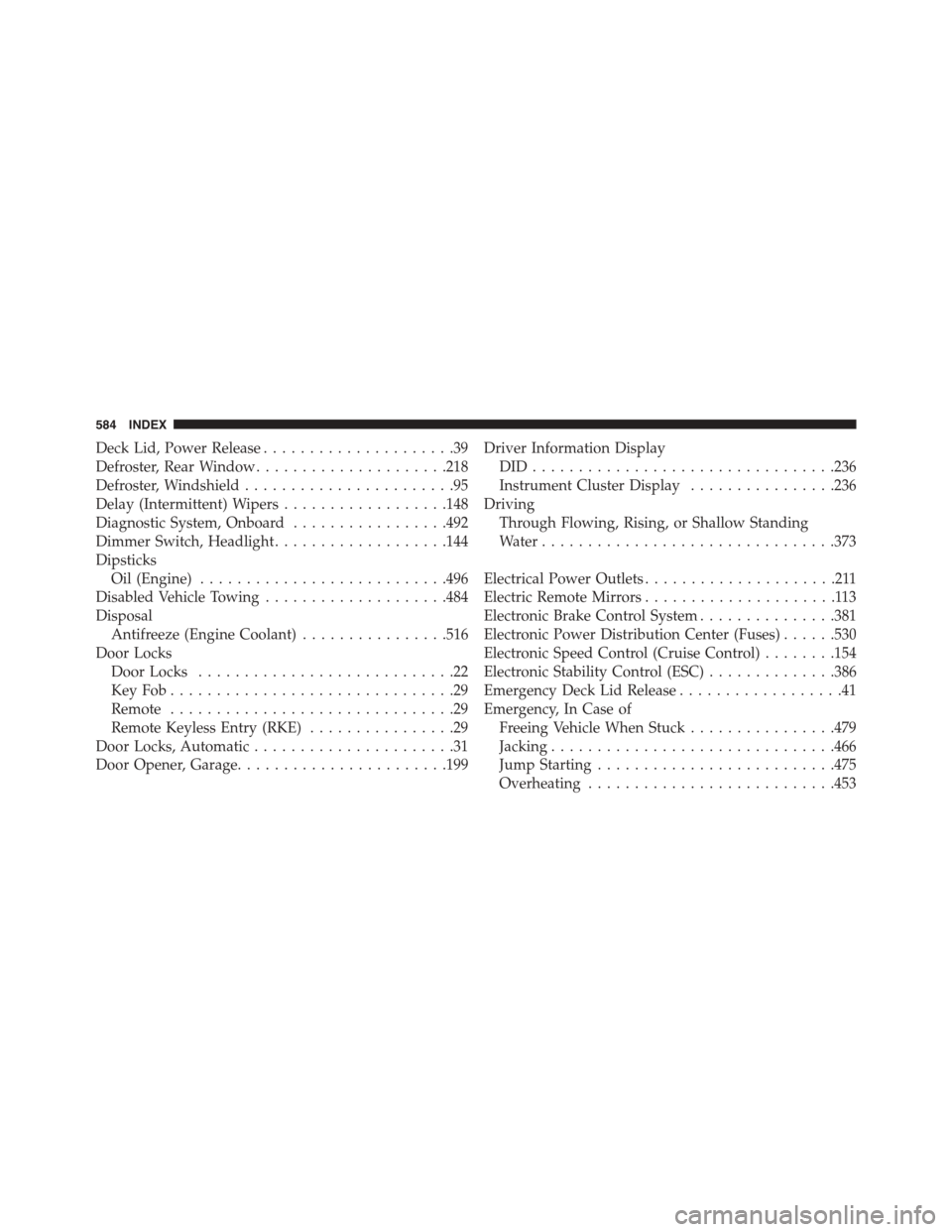Page 486 of 603
TOWING A DISABLED VEHICLE
This section describes procedures for towing a disabled
vehicle using a commercial wrecker service.
Towing Condition Wheels OFF The
Ground
AUTOMATIC TRANSMISSION MANUAL TRANSMISSION
Flat Tow NONEIf transmission is operable:
•Transmission inNEUTRAL
•30 mph (48 km/h)maxspeed
•30 miles (48 km)maxdistance
If transmission is operable:
•Transmission inNEUTRAL
•65 mph (105 km/h)max
speed
Wheel Lift or Dolly
To w
FrontNOT ALLOWEDNOT RECOMMENDED
RearNOT RECOMMENDEDNOT RECOMMENDED
FlatbedALLBEST METHODBEST METHOD
484 WHAT TO DO IN EMERGENCIES
Page 487 of 603

Proper towing or lifting equipment is required to prevent
damage to your vehicle. Use only tow bars and other
equipment designed for this purpose, following equip-
ment manufacturer ’s instructions. Use of safety chains is
mandatory. Attach a tow bar or other towing device to
main structural members of the vehicle, not to bumpers
or associated brackets. State and local laws regarding
vehicles under tow must be observed.
If you must use the accessories (wipers, defrosters, etc.)
while being towed, the ignition must be in the ON/RUN
position, not the ACC position.
CAUTION!
•Do not use sling type equipment when towing.
Vehicle damage may occur.
(Continued)
CAUTION!(Continued)
•When securing the vehicle to a flatbed truck, do not
attach to front or rear suspension components. Dam-
age to your vehicle may occur from improper towing.
•The manufacturer does not recommend towing this
vehicle using a tow dolly. Vehicle damage may occur.
Automatic Transmission
The manufacturer recommends towing your vehicle with
all four wheels OFF the ground using a flatbed.
If flatbed equipment is not available, and the transmission is
operable, the vehicle may be flat towed (with all four wheels
on the ground) under the following conditions:
•The transmission must be in NEUTRAL.
•The towing distance must not exceed 30 miles (48 km).
•The towing speed must not exceed 30 mph (48 km/h).
6
WHAT TO DO IN EMERGENCIES 485
Page 488 of 603

If the transmission is not operable, or the vehicle must
be towed faster than 30 mph (48 km/h) or farther than 30
miles (48 km), then the only acceptable method of
towing is with a flatbed truck.
CAUTION!
Towing this vehicle in violation of the above require-
ments can cause severe transmission damage. Dam-
age from improper towing is not covered under the
New Vehicle Limited Warranty.
If the key fob is unavailable, or the vehicle’s battery is
discharged, refer to “Manual Park Release” in this section
for instructions on shifting the automatic transmission
out of PARK for towing.
Manual Transmission
The manufacturer recommends towing your vehicle with
all four wheels OFF the ground using a flatbed.
If flatbed equipment is not available, and the transmis-
sion is operable, the vehicle may be flat towed (with all
four wheels on the ground) under the following condi-
tions:
•The transmission must be in NEUTRAL.
•The towing speed must not exceed 65 mph
(105 km/h).
•There is no limitation on towing distance.
If the transmission is not operable, then the only accept-
able method of towing is with a flatbed truck.
CAUTION!
Towing this vehicle in violation of the above require-
ments can cause severe engine and/or transmission
damage. Damage from improper towing is not cov-
ered under the New Vehicle Limited Warranty.
486 WHAT TO DO IN EMERGENCIES
Page 494 of 603

ONBOARD DIAGNOSTIC SYSTEM — OBD II
Your vehicle is equipped with a sophisticated onboard
diagnostic system called OBD II. This system monitors
the performance of the emissions, engine, and automatic
transmission control systems. When these systems are
operating properly, your vehicle will provide excellent
performance and fuel economy, as well as engine emis-
sions well within current government regulations.
If any of these systems require service, the OBD II system
will turn on the “Malfunction Indicator Light” (MIL). It
will also store diagnostic codes and other information to
assist your service technician in making repairs. Al-
though your vehicle will usually be drivable and not
need towing, see your authorized dealer for service as
soon as possible.
CAUTION!
•Prolonged driving with the MIL on could cause
further damage to the emission control system. It
could also affect fuel economy and driveability.
The vehicle must be serviced before any emissions
tests can be performed.
•If the MIL is flashing while the engine is running,
severe catalytic converter damage and power loss
will soon occur. Immediate service is required.
Loose Fuel Filler Cap
If the vehicle diagnostic system determines that the fuel
filler cap is loose, improperly installed, or damaged, a
”gASCAP” message will display in the odometer or a
“Check Gascap” message will display in the Driver
Information Display (DID). If this occurs, tighten the fuel
filler cap properly and press the Trip Odometer button to
492 MAINTAINING YOUR VEHICLE
Page 513 of 603

To minimize the possibility of catalytic converter dam-
age:
•Do not shut off the engine or interrupt the ignition,
when the transmission is in gear and the vehicle is in
motion.
•Do not try to start the engine by pushing or towing the
vehicle.
•Do not idle the engine with any spark plug wires
disconnected or removed, such as when diagnostic
testing, or for prolonged periods during very rough
idle or malfunctioning operating conditions.
NOTE:Your vehicles exhaust system may be equipped
with an Electronic Exhaust Valve (EEV) system, if the
exhaust system is replaced with aftermarket products a
Malfunction Indicator Lamp (MIL) may be illuminated.
Cooling System
WARNING!
•When working near the radiator cooling fan,
disconnect the fan motor lead or place the ignition
in the LOCK position (OFF position for Keyless
Enter-N-Go™). The fan is temperature controlled
and can start at any time the ignition switch is in
the ON position (RUN position for Keyless Enter-
N-Go™).
•You or others can be badly burned by hot engine
coolant (antifreeze) or steam from your radiator. If
you see or hear steam coming from under the hood,
do not open the hood until the radiator has had
time to cool. Never try to open a cooling system
pressure cap when the radiator is hot.
7
MAINTAINING YOUR VEHICLE 511
Page 561 of 603
Mileage or time passed
(whichever comes first)
20,00030,00040,00050,00060,00070,00080,00090,000100,000110,000120,000130,000140,000150,000
Or Years: 2 3 4 5 6 7 8 9 10 11 12 13 14 15
Or Kilometers:
32,00048,00064,00080,00096,000112,000128,000144,000160,000176,000192,000208,000224,000240,000
Change the manual transmissionfluid (if equipped) if using yourvehicle for any of the following:Most of your driving is at sus-tained speeds during hotweather, above 90°F (32°C),driving in dusty conditions, orstop and go driving.
XX X
Change the rear axle fluid if us-ing your vehicle for any of thefollowing: police, taxi, fleet, off-road, or frequent trailer towing.
XX X8
MAINTENANCE
SCHEDULES
MAINTENANCE SCHEDULES 559
Page 567 of 603
Miles:6,00012,00018,00024,00030,00036,00042,00048,00054,00060,00066,00072,00078,00084,00090,00096,000102,000108,00011 4 , 0 0 0120,000126,000132,000138,000144,000150,000
Or Months:6121824303642485460667278849096102108114120126132138144150
Or Kilometers:10,00020,00030,00040,00050,00060,00070,00080,00090,000100,00011 0 , 0 0 0120,000130,000140,000150,000160,000170,000180,000190,000200,000210,000220,000230,000240,000250,000
Change the engine oil andengine oil filter.XXXXXXXXXXXXXXXXXXXXXXXXX
Inspect the exhaust system.XXXXXXXX XXX
Adjust the parking brake onvehicles equipped with fourwheel disc brakes.XXXXX
Change the manual transmis-sion fluid (if equipped).XX X
Inspect the manual transmis-sion fluid (if equipped), add asnecessary.XXX
Change the rear axle fluid ifusing your vehicle for any ofthe following: police, taxi, fleetor frequent trailer towing.
XX X
Inspect the rear axle fluid.XXXXXXXX
8
MAINTENANCE
SCHEDULES
MAINTENANCE SCHEDULES 565
Page 586 of 603

Deck Lid, Power Release.....................39
Defroster, Rear Window.....................218
Defroster, Windshield.......................95
Delay (Intermittent) Wipers..................148
Diagnostic System, Onboard.................492
Dimmer Switch, Headlight...................144
Dipsticks
Oil (Engine)...........................496
Disabled Vehicle Towing....................484
Disposal
Antifreeze (Engine Coolant)................516
Door Locks
Door Locks............................22
Key Fob . . . . . . . . . . . . . . . . . . . . . . . . . . . . . . .29
Remote...............................29
Remote Keyless Entry (RKE)................29
Door Locks, Automatic......................31
Door Opener, Garage.......................199
Driver Information Display
DID . . . . . . . . . . . . . . . . . . . . . . . . . . . . . . . ..236
Instrument Cluster Display................236
Driving
Through Flowing, Rising, or Shallow Standing
Water................................373
Electrical Power Outlets.....................211
Electric Remote Mirrors.....................113
Electronic Brake Control System...............381
Electronic Power Distribution Center (Fuses)......530
Electronic Speed Control (Cruise Control)........154
Electronic Stability Control (ESC)..............386
Emergency Deck Lid Release..................41
Emergency, In Case of
Freeing Vehicle When Stuck................479
Jacking...............................466
Jump Starting..........................475
Overheating...........................453
584 INDEX